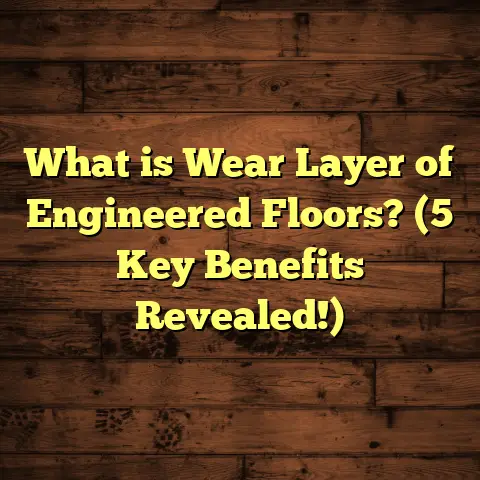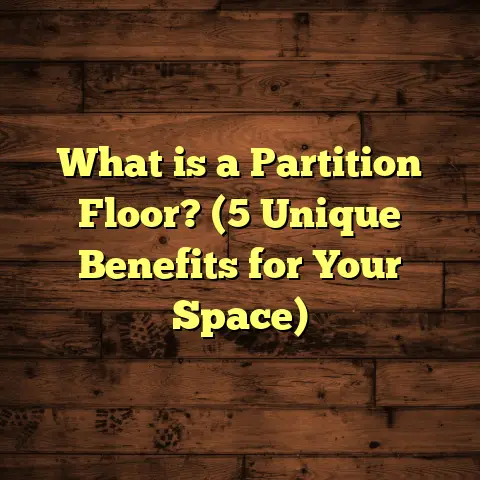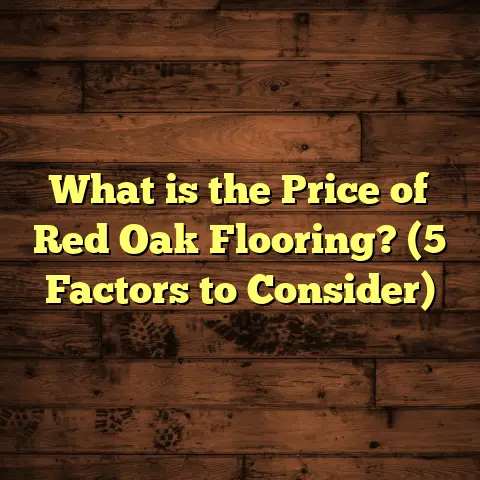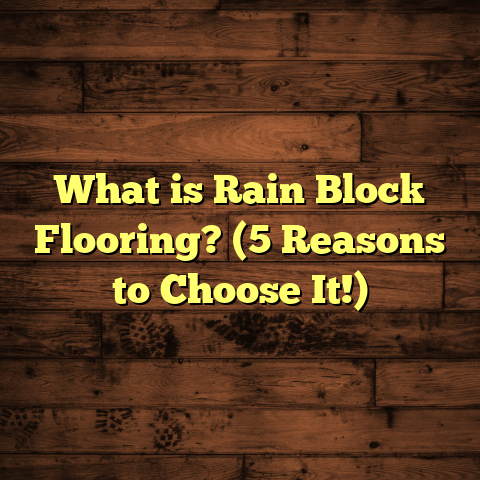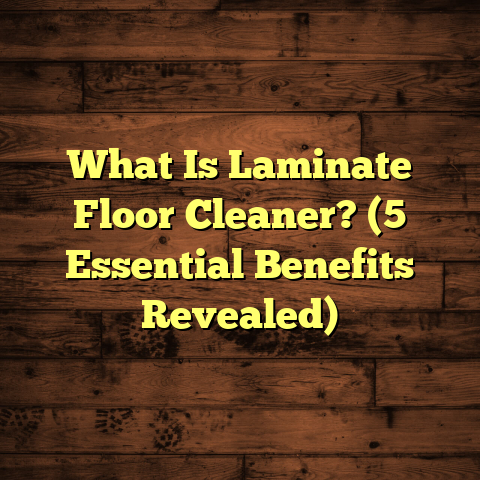What is Sheet Vinyl Flooring? (5 Key Benefits & Uses Explained)
A strange thing about sheet vinyl flooring is that it’s both incredibly simple and surprisingly versatile. At first glance, it might seem like just another synthetic floor covering, but once you get to know it, it can truly transform a space in ways you wouldn’t expect. I remember the first time I installed sheet vinyl in a client’s kitchen—it was a small project, but the results were so impressive that it made me rethink how I viewed this material.
The more floors I install, the more I see how sheet vinyl quietly outperforms expectations. It’s easy to overlook because of its price and synthetic nature, but when you dig in, you find a flooring solution that fits a wide range of needs. From budget-conscious homeowners to commercial clients seeking durability and ease of maintenance, sheet vinyl makes its case stronger every time.
Let me walk you through what sheet vinyl flooring really is, the key benefits that make it popular, where it works best, and how it stacks up against other flooring options. I’ll share stories from projects I’ve worked on, some surprising data points, and practical advice so you can decide if this flooring type is right for you.
What Is Sheet Vinyl Flooring?
So, what is sheet vinyl flooring exactly? Simply put, sheet vinyl is a type of resilient flooring made from synthetic materials like PVC (polyvinyl chloride). It comes in large, continuous sheets, typically 6 to 12 feet wide, which are rolled out and installed on the subfloor. Unlike vinyl tiles or planks that come in smaller pieces, sheet vinyl provides a seamless surface, which is one of its biggest advantages.
The manufacturing process involves layering different materials. The base layer is usually a backing made from felt or fiberglass for strength and stability. Above that is the printed design layer where manufacturers can replicate patterns like wood grain, stone, or abstract designs. On top sits a clear wear layer that protects against scratches, dents, and stains. This wear layer determines the durability of the sheet vinyl.
To give you a clearer picture: Imagine unrolling a large mat that covers your entire room floor without joints or gaps. This continuous surface means fewer places for dirt and water to sneak in. The thickness of sheet vinyl can range from 1.5 mm to over 5 mm depending on the quality and intended use.
A Bit About Construction & Types
Sheet vinyl isn’t just one kind of product. There’s heterogenous (multi-layered) and homogenous (single layer) sheet vinyl.
- Heterogeneous Sheet Vinyl: This is the most common for residential and commercial use. It has multiple layers including backing, print design, and a protective wear layer. Because of these layers, it offers better design variety and enhanced durability.
- Homogeneous Sheet Vinyl: Made from a single layer of colored vinyl throughout its thickness. This type is very durable and used often in healthcare or industrial settings because it withstands heavy wear.
You might wonder which type is right for your project? Generally, heterogeneous sheet vinyl suits homes and offices well because of its design options and comfort. Homogeneous is best when durability trumps appearance.
Thickness Matters
Thickness impacts comfort, durability, and installation ease.
- Thin sheets (1.5-2 mm) are budget-friendly but less durable.
- Medium sheets (2-3 mm) offer good balance for residential use.
- Thick sheets (3 mm+) provide commercial-grade durability and better underfoot comfort.
When I specify sheet vinyl for projects, thickness is one of my first questions—because it affects how long the floor lasts and how it feels underfoot.
5 Key Benefits of Sheet Vinyl Flooring
Let’s get into the meat of it—what makes sheet vinyl stand out?
1. Water Resistance and Durability
If you’re anything like me, you’ve seen floors ruined by water damage—warped hardwoods or swollen laminate planks are nightmares. Sheet vinyl laughs in the face of water exposure.
It’s practically waterproof due to its synthetic makeup and seamless installation. Spills sit on top instead of soaking in. This resilience makes it perfect for places where moisture is constant: kitchens, bathrooms, laundry rooms.
Here’s some data from industry sources:
- Sheet vinyl can handle standing water for up to 24 hours without damage.
- Its wear layer resists stains from common household chemicals like bleach or detergent.
In one job I did for a client with three kids and a dog, accidents were daily events. Yet the sheet vinyl held up without stains or warping after two years—something hardwood wouldn’t have survived.
Durability-wise:
- Residential-grade sheet vinyl lasts around 10-20 years.
- Commercial-grade products can exceed 25 years with proper care.
Its wear layer thickness (measured in mils) ranges from 6 mils on budget products to 40 mils on heavy-duty commercial flooring. The thicker the wear layer, the longer your floor stays pristine.
2. Seamless Appearance
One feature that often surprises new users: the beauty of a smooth, uninterrupted surface. Because sheet vinyl comes in rolls, there are far fewer seams than tile or plank floors.
Why does this matter?
- Seams are weak points where water can infiltrate.
- Fewer seams mean fewer places for dirt and grime.
- A seamless look gives rooms a clean, modern aesthetic.
I installed sheet vinyl in a modern art gallery once where clean lines were critical. The lack of seams made the space feel sleek and expansive.
3. Cost-Effective
I’m always asked about cost upfront—and here’s where sheet vinyl really shines.
Material costs range from $2 to $5 per square foot depending on quality and style. Installation typically adds $1 to $3 per square foot unless there are special requirements like complex layouts or subfloor preparation.
Compare this with:
- Hardwood flooring: $8–$15+ per square foot
- Ceramic tile: $5–$10+ per square foot
- Luxury Vinyl Plank (LVP): $3–$7 per square foot
For homeowners working with tight budgets but wanting a stylish look that holds up well over time, sheet vinyl offers exceptional value.
I recall one client who wanted to update their kitchen flooring without remodeling everything else. Sheet vinyl gave them that fresh look at less than half the cost of hardwood or tile—and installation was done in two days!
4. Comfort Underfoot
Vinyl isn’t just about looks and durability; it’s also surprisingly comfortable.
Unlike tile or stone floors that feel cold or hard underfoot, sheet vinyl has some give due to its cushioned backing layers. This makes standing or walking for long periods easier on your feet and joints.
Some premium sheets include added foam padding or cork underlays for extra softness. I personally appreciate this when working on my feet all day—it reduces fatigue noticeably.
If you’re someone who cooks often or spends time in laundry rooms or basements, this comfort factor can be a game-changer.
5. Variety of Designs
Gone are the days when vinyl was just plain sheets in basic colors. Thanks to advances in printing technology, manufacturers now create incredibly realistic designs mimicking natural materials like hardwood grain, stone veining, slate texture—even intricate patterns like Moroccan tiles or florals.
I once helped a client pick out sheet vinyl that looked exactly like hand-scraped oak flooring for their basement renovation. They got the warm feel of wood plus waterproof durability at a fraction of the cost.
You can find:
- Wood-look sheets in light oak, cherry, walnut
- Stone-look sheets resembling marble or slate
- Abstract patterns for artistic flair
- Textured surfaces that add grip
This huge selection means almost any style preference or decor scheme can be matched with sheet vinyl.
Common Uses of Sheet Vinyl Flooring
From what I’ve seen installing floors for over 15 years, here are places where sheet vinyl really shines:
Kitchens
Kitchens are high-use areas prone to spills and dropped utensils. Sheet vinyl’s waterproof nature means messes wipe up easily without worry about stains or water damage.
I installed sheet vinyl in dozens of kitchens where clients appreciated not worrying about water spills near sinks or refrigerators.
Bathrooms
Bathrooms demand moisture-resistant flooring—and sheet vinyl fits perfectly here. Its seamless installation prevents water from seeping into subfloors causing mold or rot.
One memorable bathroom project involved an elderly client who wanted slip resistance plus easy cleaning. We chose textured sheet vinyl with heat-welded seams for extra waterproofing.
Laundry Rooms
Washing machine leaks happen—sheet vinyl handles these better than laminate or wood floors which can warp easily when wet.
Commercial laundromats often use homogeneous sheet vinyl because it withstands heavy equipment vibration and constant moisture exposure.
Basements
Basements tend to be damp environments where hardwood or laminate often fail prematurely. Sheet vinyl’s moisture resistance allows safe installation over concrete slabs without risk of swelling or mold growth underneath.
A client with an unfinished basement turned their space into a cozy family rec room using wood-look sheet vinyl—a great choice for warmth plus water resistance.
Commercial Spaces
Offices, retail stores, healthcare facilities need floors that last long and clean easily. Sheet vinyl meets these demands with tough wear layers and hygienic properties such as antimicrobial coatings.
In an assisted living facility project I managed, we used hospital-grade homogeneous sheet vinyl for durability and sanitation ease—residents loved how quiet it was underfoot too.
How I Prepare and Install Sheet Vinyl Flooring
If you’re curious about what goes into installing sheet vinyl—here’s my approach based on years of hands-on experience:
Subfloor Preparation
This step makes or breaks your floor’s lifespan. The subfloor must be:
- Clean: Free of dust and debris
- Flat: No bumps or dips over 1/8 inch per 6 feet
- Dry: Moisture levels below manufacturer limits
Uneven surfaces cause bumps or bubbles showing through thin vinyl sheets later on. I always use leveling compounds as needed before installation.
Acclimation
Sheet vinyl should acclimate to room temperature for at least 24 hours before installation to avoid expansion or contraction issues later on.
Cutting and Layout
I measure carefully then cut sheets slightly larger than room dimensions allowing trimming after placement for a perfect fit.
Adhesive Application
For permanent installations, pressure-sensitive adhesives or full-spread glue are common choices depending on manufacturer recommendations.
On some commercial jobs where floors may be replaced frequently, loose-lay methods using tack strips work well too.
Seam Treatment
Seams can be sealed using heat welding or chemically welded seam tape to create waterproof joints critical in wet areas like bathrooms.
Finishing Touches
Baseboards or quarter rounds cover edges nicely while protecting them from wear or moisture intrusion.
Maintenance Tips That Keep Your Sheet Vinyl Looking New
Keeping your floor fresh is easier than most people think:
- Sweep or vacuum regularly to prevent grit scratching surface.
- Mop with mild detergent solutions—not harsh chemicals.
- Avoid abrasive pads that can damage wear layers.
- Use felt pads under furniture legs to prevent dents.
- Clean spills immediately to avoid staining.
I’ve seen clients extend their floor life by years just by following simple care routines like these.
Some Numbers Worth Knowing
Here are some interesting stats related to sheet vinyl flooring from industry reports:
| Attribute | Typical Range / Value |
|---|---|
| Material Cost | $2 – $5 per sq ft |
| Installation Cost | $1 – $3 per sq ft |
| Wear Layer Thickness | 6 – 40 mils |
| Expected Lifespan | 10 – 25 years |
| Water Resistance | Highly resistant |
| Maintenance Frequency | Weekly sweeping/mopping |
These figures help you understand why many homeowners and businesses pick this flooring type for long-term value combined with low upkeep expenses.
Comparing Sheet Vinyl Flooring With Other Popular Options
How does it measure up against laminate, hardwood, luxury vinyl plank (LVP), tile?
| Feature | Sheet Vinyl | Laminate | Hardwood | LVP | Tile |
|---|---|---|---|---|---|
| Water Resistance | Excellent | Poor/Moderate | Poor | Good | Excellent |
| Seamless Look | Yes | No | No | No | No |
| Comfort Underfoot | Soft | Hard | Hard | Moderately soft | Hard |
| Installation Cost | Low | Moderate | High | Moderate | High |
| Durability | Moderate to High | Moderate | High | High | Very High |
| Design Variety | Wide | Moderate | Natural variety | Wide | Wide |
| Maintenance | Easy | Moderate | Requires care | Easy | Moderate |
Sheet Vinyl vs Laminate: Laminate imitates wood better but struggles with moisture. For kitchens/bathrooms where water exposure is frequent, sheet vinyl wins because laminate swells when wet.
Sheet Vinyl vs Hardwood: Hardwood offers unmatched warmth and resale value but requires more maintenance and isn’t ideal near water sources without precautions.
Sheet Vinyl vs LVP: LVP is trendy because planks simulate hardwood texture closely but has more seams where dirt/water can accumulate than seamless sheet vinyl.
Sheet Vinyl vs Tile: Tile excels in durability but feels cold/hard underfoot and costs more upfront plus installation difficulty increases labor costs substantially compared to rolling out sheet vinyl quickly.
Real-Life Case Studies I’ve Worked On
Case Study 1: Family Kitchen Renovation
A family with three young kids wanted an affordable kitchen floor upgrade that could handle spills and heavy foot traffic without looking cheap. We chose mid-grade heterogeneous sheet vinyl with wood grain patterning.
Result: After two years of daily use with no visible wear spots or water damage—kids’ juice spills cleaned easily—parents praised how warm it felt on bare feet compared to their old tile floor.
Case Study 2: Assisted Living Facility Flooring
In this commercial project involving multiple resident rooms and communal areas:
- We installed homogeneous sheet vinyl with antimicrobial coatings.
- Heat-welded seams ensured no water seepage.
- Cushioned backing helped reduce noise levels improving resident comfort.
After three years maintenance costs dropped by 30% compared to previous rubberized flooring they had—cleaning was simpler too.
Design Trends & Innovations in Sheet Vinyl Flooring
The market keeps evolving with new finishes and eco-friendlier options:
- Textured Surfaces: Matte finishes with subtle embossing mimic real wood grain better than ever.
- Wider Rolls: Some manufacturers now offer rolls up to 12 feet wide reducing seams even further.
- Recycled Content: Eco-conscious buyers find options incorporating recycled PVC materials.
- Antimicrobial Coatings: Especially valuable in healthcare spaces now popular in residential too.
- Enhanced Wear Layers: New polymers improve scratch resistance beyond traditional standards.
If you want your home to feel modern but practical—sheet vinyl can tick those boxes while staying within budget constraints many people face today.
Final Thoughts: Is Sheet Vinyl Flooring Right For You?
If you’re asking yourself whether sheet vinyl will fit your lifestyle and budget—the answer depends on priorities:
- Want something waterproof yet comfortable? Check.
- Need quick installation without fuss? Check.
- Looking for affordable flooring that doesn’t look cheap? Check.
- Desire many design options? Check.
It might not have the prestige of hardwood floors or the permanence of tile—but if ease of maintenance, cost efficiency, and versatility matter most—you’ll find few better options than sheet vinyl flooring.
Feel free to ask if you want installation tips tailored to your space or help choosing styles—I’ve spent years working hands-on with this material and love sharing what I’ve learned!
